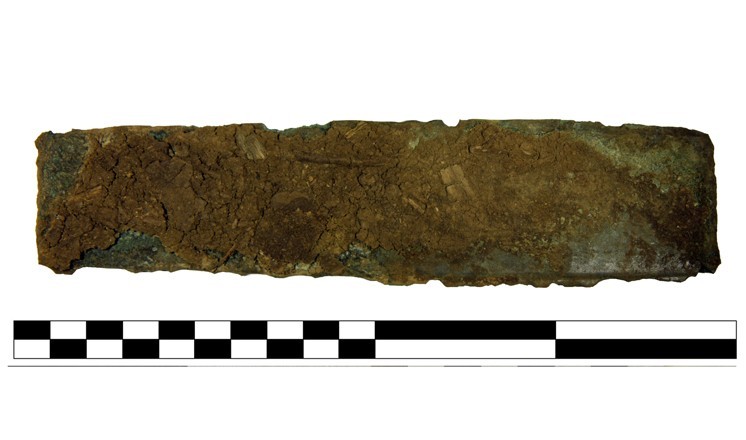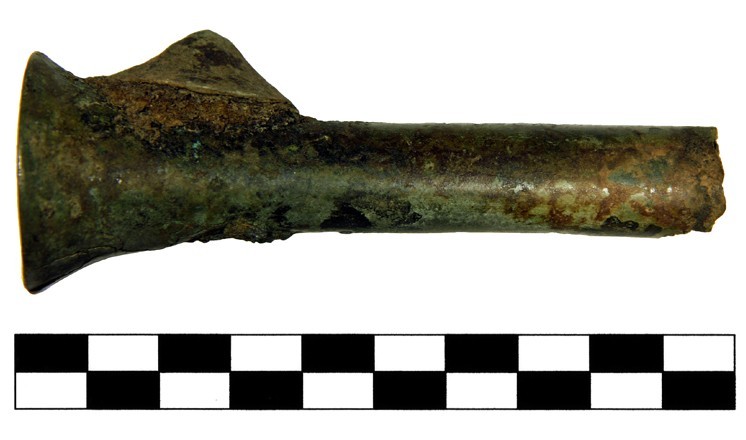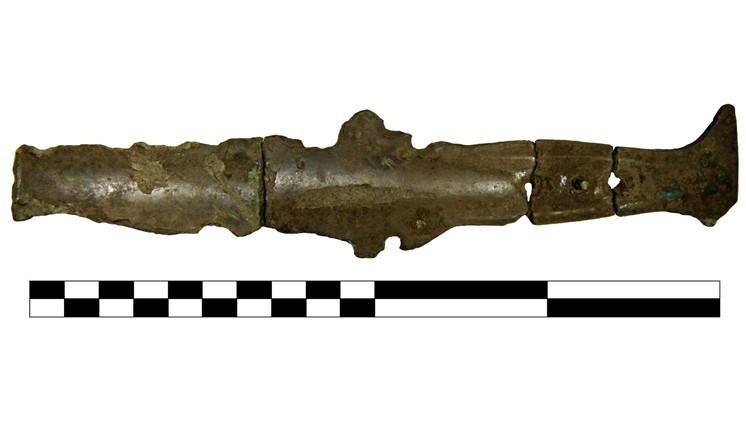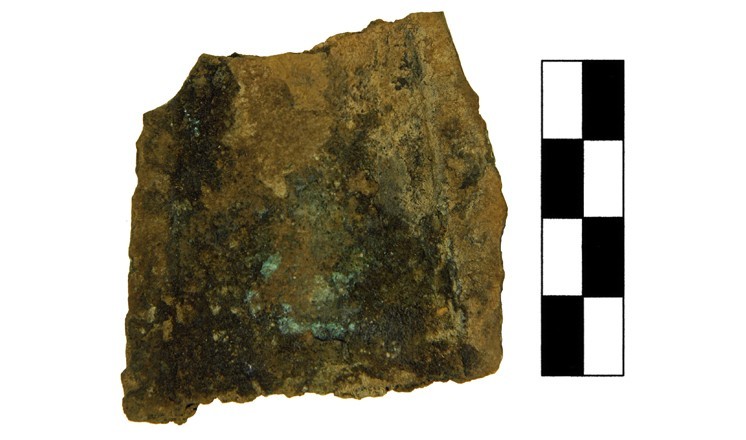Late Bronze Age weapon depositions - the case of the Tattershall hoard
RSS FeedThe so-called ‘Tattershall hoard’ is the latest addition to a number of extensive weapon assemblages that were deliberately given up during the Late Bronze Age (c. 1150-800 BC). These finds are a special phenomenon in Britain and the main focus of my ongoing PhD, which I’m writing at the Institute of Prehistoric Archaeology of the Free University in Berlin under the supervision of Prof. Svend Hansen, head of the Eurasia Department of the German Archaeological Institute. The aim is to come up with a plausible explanation for why these extraordinary hoards were abandoned. Therefore, I’m especially interested in traces of use which cannot certainly be identified with the help of the published drawings or photographs. Thanks to the financial support from the Elsa Neumann grant of county Berlin, I’m able to travel to those institutions where the finds are now housed in order to conduct first-hand research. For the purpose of my studies I visited The Collection Museum in Lincoln for one week in March 2014, where I benefited a lot from the kind hospitality of all the staff, in particular curator Antony Lee.
The Tattershall hoard was discovered by metal-detectorists between February and November 2006 near Stixwould close to Witham River. Most of the items were ploughed out of context in previous years, though others still have organic material adhering, indicating that these were in situ when found. Unfortunately, no further information on the arrangement of the artefacts is available and since no archaeological fieldwork had been carried out yet, it remains unclear if the assemblage can be regarded as completely recovered or not. The find spot lies adjacent to the present course of Witham River and was probably once a tidal inlet. It is likely that the deposition took place exactly at the margins of the wetland, a landscape setting that corresponds with the findspots of other Late Bronze Age weapon hoards, for instance Bramber (West Sussex), Broadward (Shropshire) and Peelhill Farm (South Lanarkshire). The Witham valley is well known for prehistoric ritual finds with the Iron and Roman Age offerings along the timber causeway at Fiskerton as the most prominent example.
My research confirmed earlier observations, which claimed that nearly all artefacts of the Tattershall hoard were deliberately damaged before deposition. While this is a common feature of Late Bronze Age metalwork assemblages, the very one-sided selection of weapons, mainly spearheads, and the absence of the otherwise omnipresent axeheads mark the find as special. So far, the artefacts of the Tattershall hoard have not been professionally cleaned and restored, restricting observations concerning their use-life. However, most of the breaks do appear to be ancient and intentional, i.e. the weapons were purposefully destroyed in the process of deposition. In contrast, relatively shallow nicks, which are observable along the blade edges of the swords and spearheads, were almost certainly caused by physical contact with another weapon, thus indicating their employment in warlike activities. Experimental testing with modern replicas was able to reproduce comparable damage.
In view of the important fact that the ancient defects had not been mended, which would have been feasible without great effort, a martial deployment is thought likely to have ended the use of the artefacts. Instead of restoring their functionality, something that may have happened several times before, the weapons were further destroyed. In other cases, e.g. the hoards from Blackmoor (Hampshire) or Wilburton (Cambridgeshire), deep and regular notches are visible, sometimes appearing together with shallow nicks on the same weapon. Because of their quantity and force the former should rather be regarded as another kind of wanton destruction, probably brought about by the purposeful employment of axes. Comparable damage is so far not traceable on the finds from Tattershall.
The Tattershall hoard consists of a large number of individual pieces, though these are mostly very small. Through counting unique parts, like tips and sockets of spearheads, and trying to reconstruct once destroyed artefacts, a minimal number of each category can be assessed. In all, 180 fragments were counted. These belonged to at least 18 spearheads, two swords and six ferrules, which had formerly been attached to the butt-end of spear-shafts. Two awls, three buttons, two rings and a further ferrule are complete with only minor damage. The actual amount of artefacts is thus relatively limited. In spite of the very fragmentary state of nearly all items, it can be inferred that some weapons, especially the swords, are surely incomplete. If this is due to the circumstances of discovery or if the affected pieces were abandoned only partially in the Bronze Age, remains open to question.
Of special interest is the presence of two fragments of so-called “barbed spearheads”. These have relatively broad and parallel blades, which often form sharp angles when departing from the socket – hence their name. Such weapons are a key feature of extensive spearhead hoards, with only very few or even no swords. Since the majority of these deposits have been found in the Welsh Marshes, especially in Shropshire, it was long believed to be a phenomenon mainly restricted to western Britain. However, a similar assemblage dredged from the River Thames at Broadness (Kent) in the 19th century and the more recent discovery at Bramber (West Sussex) are proof of a more widespread distribution, which includes south-eastern England. In view of its composition and the presence of at least one barbed spearhead, the Tattershall find should be grouped with this class of hoards and to the late 10th to 9th century BC.
The interpretation of Bronze Age deposits in Britain had been, and still partly is, heavily influenced by economic considerations, often assuming that the artefacts were broken and buried as a metal reserve with the intent of recycling. However, in the case of Tattershall neither the unsystematic manner of damage, evident on the weapons, nor the place of deposition in a damp environment fits well with such an explanation. Rather, the items show traces of their use-life, i.e. an employment in violent action against other humans, and ritual damage inflicted on them in the course of their abandonment. Therefore, the items were most likely to have been collected after warlike events by the victors and subsequently consecrated to suprahuman beings. The reasons for such weapon hoarding are thus, I would strongly argue, of a cultic kind.
Analogous activities are known archaeologically and historically in other times and regions. They are commonly referred to as “war booty offerings”. In ancient Greece as well as in Late Iron Age Gaul the captured arms and armour were consecrated and publicly presented in sanctuaries. The closest parallel to the extensive weapon hoards of Late Bronze Age Britain are the massive bog finds of northern Europe dating to the Roman Iron Age and Migration Period, e.g. Illerup Ådal, Nydam and Thorsberg in Jutland or Vimose on the island of Fyn.
For the future, a professional restoration of the finds from Tattershall is recommended. After cleaning it would be much easier to judge which fragments may belong to one weapon. Further traces of use may also become obvious. Some of the spearheads still have wooden shaft remains in their sockets. This allows for the employment of radiocarbon measurements in order to determine the absolute age of the artefacts in addition to their relative dating by typological reasoning. In sum, the Tattershall hoard is a remarkable discovery of supra-regional importance, worthy of further work and a detailed publication.
Entry on the Portable Antiquites website (Record-ID: LIN-CEDC78):
http://finds.org.uk/database/artefacts/record/id/176082
Further reading:
Dot Bruns/Adam Daubney, Tattershall Area, Lincolnshire: Bronze Age base-metal group (2006 T308). Treasure Annual Report 2005/06, 28-32.
http://finds.org.uk/treasure/reports/2005-2006
Colin Burgess/David Coombs/D. Gareth Davies, The Broadward Complex and Barbed Spearheads. In: Frances Lynch/Colin Burgess (eds.), Prehistoric Man in Wales and the West. Essays in honour of Lily F. Chitty (Bath 1972) 211-283.
David Coombs, Bronze Age Weapon Hoards in Britain. Archaeologia Atlantica 1.1, 1975, 49-81.
Barry P. C. Molloy, What’s the bloody point?: Bronze Age swordsmanship in Ireland and Britain. In: Barry P. C. Molloy, The Cutting Edge. Studies in Ancient and Medieval Combat (Stroud 2007) 90-111.
Barry Molloy, Use-wear analysis and use-patterns of Bronze Age swords. In: Marion Uckelmann/Marianne Mödlinger (eds.), Bronze Age warfare: Manufacture and use of weaponry. British Archaeological Reports International Series 2255 (Oxford 2011) 67-84.
http://www.academia.edu/1289907/Use-wear_analysis_and_use-patterns_of_Bronze_Age_swords
Tobias Mörtz, Spätbronzezeitliche Waffendeponierungen Großbritanniens. Archäologische Informationen 33.1, 2010, 153-157.
https://www.academia.edu/2075343/Spatbronzezeitliche_Waffendeponierungen_Grossbritanniens
http://journals.ub.uni-heidelberg.de/index.php/arch-inf/article/view/10184
David Yates/Richard Bradley, The Siting of Metalwork Hoards in the Bronze Age of South-East England. The Antiquaries Journal 90, 2010, 41-72.
David Yates/Richard Bradley, Still water, hidden depths: the deposition of Bronze Age metalwork in the English Fenland. Antiquity 84, 2010, 405-415.
Tobias Mörtz
Freie Universität Berlin
Institut für Prähistorische Archäologie
Fabeckstrasse 23-25
14195 Berlin
Comments
There aren’t any comments for this blog yet




